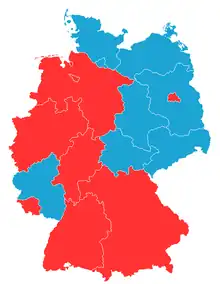Islam in Germany
Islam's significance in Germany has largely increased[3] after the labour migration in the 1960s and several waves of political refugees since the 1970s.

| 90–100% | |
| 70–90% | |
| 50–70% | Bosnia and Herzegovina |
| 30–40% | North Macedonia |
| 10–20% | |
| 5–10% | |
| 4–5% | |
| 2–4% | |
| 1–2% | |
| < 1% |
| Islam by country |
|---|
 |
|
|
 Şehitlik-Moschee, Berlin. | |
| Total population | |
|---|---|
| More than 5.3–5.6 million (6.4–6.7%) in 2019[2] | |
| Regions with significant populations | |
| Berlin, Hamburg, North Rhine-Westphalia, Baden-Württemberg, Bavaria, Hesse, Lower Saxony (incl. Bremen) | |
| Religions | |
| Sunni Islam (majority), Alevism, Ahmadiyya, Shia Islam | |
| Languages | |
| Main: German, Turkish, Arabic |
| Islam by country |
|---|
 |
|
|

According to a representative survey, it is estimated that in 2019, there were 5.3–5.6 million Muslims with a migrant background[lower-alpha 1] in Germany (6.4–6.7% of the population), in addition to an unknown number of Muslims without a migrant background.[2] A similar survey in 2016 estimated a number of 4.4–4.7 million Muslims with a migrant background (5.4–5.7% of the population) at that time.[4] An older survey in 2009 estimated a total number of up to 4.3 Muslims in Germany at that time.[5] There are also higher estimates: according to the German Islam Conference, Muslims represented 7% of the population in Germany in 2012.[6]
In a 2014 academic publication it was estimated that some 100,000 Germans converted to Islam, numbers which are comparable to that in France and in the United Kingdom.[7]
Demographics
Islam is the largest minority religion in the country, with the Protestant and Roman Catholic confessions being the majority religions.[8][9][10] Most Muslims in Germany have roots in Turkey,[11] followed by Arab countries, former Yugoslavia (mostly of Kosovo-Albanian or Bosnian origin), Afghanistan and Iran. There are also a significant minority originated from Sub-Saharan Africa (mostly East Africa) and South Asia (mostly Pakistan). The large majority of Muslims live in former West Germany, including West Berlin. However, unlike in most other European countries, sizeable Muslim communities exist in some rural regions of Germany, especially Baden-Württemberg, Hesse and parts of Bavaria and North Rhine-Westphalia. Owing to the lack of labour immigration before 1989, there are only very few Muslims in the former East Germany. Among the German districts with the highest share of Muslim migrants are Groß-Gerau (district) and Offenbach (district) according to migrants data from the census 2011.[12] The majority of Muslims in Germany are Sunnis, at 75%. There are Shia Muslims (7%) and mostly from Iran. The Ahmadiyya Muslim Community organization comprise a minority of Germany's Muslims, numbering some 35,000 members or a little over 1% of the Muslim population,[13] and are found in 244 communities[13] as of 2013.
From the mid-2000s to 2016 there has been a surge migrants to Germany from outside Europe. Of the 680,000 regular migrants, 270,000 were Muslim. Additionally, of the 1,210,000 asylum seekers, 900,000 were Muslim (around 74%). Of the asylum seekers, 580,000 applicants were approved and 320,000 were denied or expected to be denied. According to the Pew Research Center, similar patterns of Muslim migration to Germany should be expected in the future and the Muslim population share is expected to grow.[14]
Prison population
According to the Huffington Post in February 2018 which quired each of the 15 state justice ministries, 12,300 Muslims are in prison and constitute about 20% of the total 65,000 prison population in Germany which constitutes an over-representation. The highest shares are in city states of Bremen (29%), Hamburg (28%) but the share is high also in large states such as Hessen (26%) Baden-Württemberg (26%). The share is lower in the former East Germany.[15]
History
Early history
Muslims first moved to Germany as part of the diplomatic, military and economic relations between Germany and the Ottoman Empire in the eighteenth century.[16] Twenty Muslim soldiers served under Frederick William I of Prussia, at the beginning of the eighteenth century. In 1745, Frederick II of Prussia established a unit of Muslims in the Prussian army called the "Muslim Riders" and consisting mainly of Bosniaks, Albanians and Tatars. In 1760 a Bosnian Muslim corps was established with about 1,000 men.[17] In 1798 a Muslim cemetery was established in Berlin. The cemetery, which moved in 1866, still exists today. A number of German philosophers expressed sympathy for Islam, including Johann Wolfgang von Goethe (who particularly admired the Sufi poetry of Hafez)[18] and later Friedrich Nietzsche (in The Antichrist, he claimed that the Germanic spirit was closer to the Moors of Al-Andalus than that of Greece, Rome and Christianity).
The German Empire had over two million Muslim subjects, mostly Sunnis, in overseas colonies. The Majority lived in German East Africa.[19] Several Muslim revolts against German colonial rule occurred, including the Adamawa Campaign, Maji Maji Rebellion and Abushiri revolt.
1920s to the 1940s

The Islamic Institut Ma’ahad-ul-Islam was founded in 1927 and is now known under the name "Zentralinstitut Islam-Archiv-Deutschland" (Central Islamic Archive Institute) and is the oldest such institution in Germany. Shortly after its founding the Nazi Party came to power the archive was forced to suspend all further work, until after the war. During World War II Grand Mufti of Jerusalem Haj Amin al-Husseini energetically recruited Muslims from occupied territories into several divisions of the Waffen SS (primarily the 13th Waffen Mountain Division of the SS Handschar (1st Croatian) and 21st Waffen Mountain Division of the SS Skanderbeg) and some other units.
Post-war Germany
After the West German Government invited foreign workers ("Gastarbeiter") in 1961, the figure sharply rose to currently 4.3 million (most of them Turkish from the rural region of Anatolia in southeast Turkey). They are sometimes called a parallel society within ethnic Germans.[20]
According to the German statistical office 9.1% of all newborns in Germany had Muslim parents in 2005.[21]
In 2017, Muslims and Islamic institutions were targeted by attacks 950 times, where houses are painted with Nazi symbols, hijab-wearing women are harassed, threatening letters are sent and 33 people were injured. In nearly all cases, the perpetrators were right-wing extremists.[22]
In May 2018 a court in Berlin upheld the right to the state's neutrality principle by barring a primary school teacher from wearing a headscarf during classes, where the court spokesman stated that children should be free of the influence that can be exerted by religious symbols.[23]
According to a study in 2018 by Leipzig University, 56% of Germans sometimes thought the many Muslims made them feel like strangers in their own country, up from 43% in 2014. In 2018, 44% thought immigration by Muslims should be banned, up from 37% in 2014.[24]
In December 2018, the government of Germany strengthened the control of Saudi, Kuwaiti and Qatari funding for radical mosque congregations. The measure was recommended by an anti-terrorist agency in Berlin (German: Terrorismus-Abwehrzentrum) which since 2015 had started to monitor Safalist proselytizing funding in the wake of the European migrant crisis to prevent refugees from becoming radicalized. Henceforth Gulf authorities are required to report payments and funding to the German Federal Foreign Office (German: Auswärtiges Amt).[25][26]
Between 2010 and 2016, the number of Muslims living in Germany increased from 3.3 million (4.1% of the population) to nearly 5 million (6.1%). The most important factor in the growth of Germany’s Muslim population is immigration.[27]
In December 2018, there were no official statistics on how much funding mosques in Germany received from abroad.[25]
In July 2020, federal state Baden-Württemberg banned face-covering veils for school pupils as an extension of the ban which was already in force for staff.[28]
Denominations


Muslims in Germany belong to several different branches of Islam (approximate data):
Islamic organisations
Only a minority of the Muslims residing in Germany are members of religious associations.
Sunni
- Diyanet İşleri Türk İslam Birliği (DİTİB): German branch of the Turkish Presidency for Religious Affairs, Cologne. As of 2016, the Turkish government funds and provides staff for 900 of Germany's roughly 3000 mosques run by DİTİB.[34]
- Islamische Gemeinschaft Milli Görüş: close to the Islamist Saadet Partisi in Turkey, Kerpen near Cologne
- Islamische Gemeinschaft Jamaat un-Nur (de): German branch of the Risale-i Nur Society (Said Nursi)
- Islamische Gemeinschaft in Deutschland organization of Arab Muslims close to the Muslim Brotherhood, Frankfurt
In addition there are numerous local associations without affiliation to any of these organisations. Two organisations have been banned in 2002 because their programme was judged as contrary to the constitution: The "Hizb ut-Tahrir" and the so-called "Caliphate State" founded by Cemalettin Kaplan and later led by his son Metin Kaplan.
Shia
- Islamische Gemeinschaft der schiitischen Gemeinden Deutschlands (IGS): Head organization that unite all Shiite mosques and associations in Germany, with being the Islamic Centre Hamburg the most important Shia mosque in Germany.
- Al-Mustafa Institut Berlin: A branch of the Al-Mustafa International University in Qum, Iran to Islamic theology to students in Germany and Europe.
Ahmadiyya
- Ahmadiyya Muslim Jamaat Deutschland K.d.ö.R.: German branch of the worldwide Ahmadiyya Community. There is no ethnicity or race associated with this community although most of the members of the community residing in Germany are of Pakistani origin. The Ahmadiyya Community was established in Germany in 1923 in Berlin and is one of the largest in Europe. Communities exist in Baden-Württemberg, Lower Saxony, North Rhine-Westphalia, Hesse and Bremen.[35]
- Lahore Ahmadiyya Movement: German branch of the worldwide Lahore Ahmadiyya Movement.
Liberal Islam
- Ibn Ruschd-Goethe mosque in Berlin was founded by Seyran Ateş. The liberal mosque has been condemned by the Turkish religious authority and the Egyptian Fatwa Council at the Al-Azhar University.[36][37]
- Ibn Rushd Prize for Freedom of Thought
Wahhabism
- King Fahd Academy, sponsored by Saudi Arabia. The school was closed at the end of the 2016/2017 school year, after long-running criticism that it was attracting Islamists to Germany.[38]
- According to the FFGI at Goethe University Frankfurt, wahhabist ideology is spread in Germany as in other European country mostly by an array of informal, personal and organisational networks, where organisations closely associated with the government of Saudi Arabia such as the Muslim World League (WML) and the World Association of Muslim Youth are actively participating.[39]
Others
- Verband der islamischen Kulturzentren: German branch of the conservative Süleymancı sect in Turkey, Cologne
- Verband der Islamischen Gemeinden der Bosniaken: Bosnian Muslims, Kamp-Lintfort near Duisburg
- Zentralinstitut Islam-Archiv-Deutschland e.V. : Documentary of Islamic Foundation-writings since 1739. The Islamic Institute was founded in 1942 (Sooner called Ma’ahad-ul-Islam Institut).
Umbrella organisations
Furthermore, there are the following umbrella organisations:
- Central Council of Muslims in Germany (Zentralrat der Muslime in Deutschland)
- Islamic Council in Germany (Islamrat in Deutschland)
Education
- The A-Nur-Kita preschool was closed in February 2019 due to its parent organisation, the mosque association Arab Nil Rhein in Mainz propagated material from the Muslim Brotherhood and salafist ideology. Therefore, the parent association was incompatible with the constitution of Germany. This was the first time authorities closed any preschool in Rhineland-Palatinate (German: Rheinland-Pfalz). A-Nur-Kita was the first and only Muslim preschool in Rhineland-Palatinate.[40]
Controversies
As elsewhere in Western Europe, the rapid growth of the Muslim community in Germany has led to social tensions and political controversy, partly connected to Islamic extremism, and more generally due to the perceived difficulties of multiculturalism and fears of Überfremdung.
Antisemitism
A 2012 poll showed that 18% of the Turks in Germany think of Jews as inferior human beings.[42][43] A 2017 study on Jewish perspectives on antisemitism in Germany by Bielefeld University found that individuals and groups belonging to the extreme right and extreme left were equally represented as perpetrators of antisemitic harassment and assault, while the largest part of the attacks were committed by Muslim assailants. The study also found that 70% of the participants feared a rise in antisemitism due to immigration citing the antisemitic views of the refugees.[44] Many of this started in 2015 when a large quantity of islamic refugees entered Germany.[45]
According to the Federal Office for the Protection of the Constitution, the majority of Islamist organizations in Germany cultivate antisemitic propaganda and distribute it in various ways.[46]
In the education system

One issue concerns the wearing of the head-scarf by teachers in schools and universities. The right to practice one's religion, stated by the teachers in question, contradicts in the view of many the neutral stance of the state towards religion. As of 2006, many of the German federal states have introduced legislation banning head-scarves for teachers. However, such a ban in North-Rhein Westphalia was declared as unconstitutional in 2015 by the Federal Constitutional Court.[47]
In the German federal states with the exception of Bremen, Berlin and Brandenburg, lessons of religious education overseen by the respective religious communities are taught as an elective subject in state schools. It is being discussed whether apart from the Catholic and Protestant (and in a few schools, Jewish) religious education that currently exists, a comparable subject of Islamic religious education should be introduced as a regular part of the curricula. In several states, trials for Islamic religious education are being conducted, while in the states of Hessen, Lower-Saxony and Northrhine-Westphalia, Islamic religious education already is integrated as a regular class. The problem that the cooperation with Islamic organisations is hampered by the fact that none of them can be considered as representative of the whole Muslim community.
The discussion of religious (Islamic) education in German schools started in the 1970s, and also symmetrically with issues of Qur'anic classes as well as its deterrent effects on the integration of Turkish students into the country.[48]
Construction of mosques and other projects
The construction of mosques is occasionally resisted by anti Muslim reactions in the neighborhoods concerned. For example, in 2007 an attempt by Muslims to build a large mosque in Cologne sparked a controversy.[49]
There are now 18 official mosques in the country that have been established as mosques since time immemorial. Muslim places of worship (such as mosques and other places of worship) are estimated at between 1,000 and 1,200. Most of these mosques are temporarily built and are mostly located in rented places, factories or warehouses. According to the archives of the Central Institute of Islam, the most important mosques in Germany are located in cities such as Hamburg, Berlin, Mannheim, Marl, Dortmund, Cologne, Frankfurt, Wesling, Bonn, Zingen, Fortsheim, as well as mosques. The cities of Aachen and Munich are important mosques in Germany. These mosques are far from the city center and are often located in industrial areas.[48]
Islamic Theological Studies
In 2010, the German Ministry of Education and Research established Islamic Theological Studies as an academic discipline at public universities in order to train teachers for Islamic religious education and Muslim theologians. Since then, Islamic theological departments have been established at several universities, conducting research and teaching on Islam from a theological perspective.[50]
Islamic fundamentalism
Concerns of Islamic fundamentalism came to the fore after 11 September 2001, especially with respect to Islamic fundamentalism among second- and third-generation Muslims in Germany - the Hamburg cell, which included Mohamed Atta, was prominent in the planning and execution of 11 September attacks. Also the various confrontations between Islamic religious law (Sharia) and the norms of German Grundgesetz and culture are the subject of intense debate. German critics include both liberals and Christian groups. The former claim that Islamic fundamentalism violates basic fundamental rights whereas the latter maintain that Germany is a state and society grounded in the Christian tradition.
According to a 2007 Federal Ministry of the Interior report almost half of all young Muslims in Germany support fundamentalist views. About 12% of Muslims in Germany identified with moral-religious criticism against Western societal values in combination with corporal punishment up to and including the death penalty.[51]
According to a 2012 poll, 72% of the Turks in Germany believe that Islam is the only true religion and 46% wish that one day more Muslims live in Germany than Christians.[52][53][54] According to a 10-year survey by the University of Bielefeld, which dealt with different aspects of attitudes to Islam, "distrust" of Islam is widespread in Germany with only 19 per cent of Germans believing that Islam is compatible with German culture.[55]
According to 2013 study by Social Science Research Center Berlin, two thirds of the Muslims interviewed say that religious rules are more important to them than the laws of the country in which they live, almost 60 per cent of the Muslim respondents reject homosexuals as friends; 45 per cent think that Jews cannot be trusted; and an equally large group believes that the West is out to destroy Islam (Christian respondents’ answers for comparison: As many as 9 per cent are openly anti-Semitic; 13 per cent do not want to have homosexuals as friends; and 23 per cent think that Muslims aim to destroy Western culture).[56]
According to a 2012 poll, 25% of the Turks in Germany believe atheists are inferior human beings.[53][57]
Salafism
Salafism is a part of the Sunni branch of Islam which is a revival of original Islamic ideals.[58] Salafists strive to live exclusively according to the Quran and Sunnah. According to German authorities, Salafism is incompatible with the principles codified in the Constitution of Germany, in particular democracy, the rule of law and a political order based on human rights.[59] According to the German security service, the Salafist movement attracts rising numbers. In 2011 there were an estimated 3800 Salafists in Germany, which rose to 10300 in September 2017.[60] According to head of security office Hans-Georg Maaßen, the Salafist scene in Germany is not dominated by any one single individual, but instead a great many persons have to be monitored.[61]
According to German Federal Agency for Civic Education, the Salafist movement in Germany is centered in the Frankfurt Rhine-Main metropolitan area, North Rhine-Westphalia and Berlin. In these areas, mosques and charismatic imams are the driving factors behind recruitment to the Salafist movement.[62]
In 2016, the interior ministry of North Rhine-Westphalia reported that the number of mosques with a Salafist influence had risen from 30 to 55, which indicated both an actual increase and improved reporting.[63]
In February 2017, the German Salafist mosque organisation Berliner Fussilet-Moscheeverein was banned by authorities. Anis Amri, the perpetrator of the 2016 Berlin truck attack, was said to be among its visitors. In March 2017, the German Muslim community organisation Deutschsprachige Islamkreis Hildesheim was also banned after investigators found that its members were preparing to travel to the conflict zone in Syria to fight for the Islamic State. According to the Federal Agency for Civic Education, these examples show that Salafist mosques not only concern themselves with religious matters, but also prepare serious crimes and terrorist activities.[62]
Islamist scene in Germany
Turkish and Kurdish Islamist groups are also active in Germany, and Turkish and Kurdish Islamists have co-operated in Germany as in the case of the Sauerland terror cell.[64] Political scientist Guido Steinberg stated that many top leaders of Islamist organizations in Turkey fled to Germany in the 2000s, and that the Turkish (Kurdish) Hizbullah has also "left an imprint on Turkish Kurds in Germany."[64] Also many Kurds from Iraq (there are about 50,000 to 80,000 Iraqi Kurds in Germany) financially supported Kurdish-Islamist groups like Ansar al Islam.[64] Many Islamists in Germany are ethnic Kurds (Iraqi and Turkish Kurds) or Turks. Before 2006, the German Islamist scene was dominated by Iraqi Kurds and Palestinians, but since 2006 Kurds and Turks from Turkey are dominant.[64]
In 2016, the German security service estimated that about 24 000 Muslims were part of Islamists movements in Germany, of which 10 000 belonged to the Salafist scene.[62]
In 2016, 90 mosques were monitored by the Federal Office for the Protection of the Constitution for their islamist ideology. These were mostly Arabic-language "backyard mosques" where self-appointed imams exhorted their followers to wage jihad.[65]
Since the start of 2017 until April 2018, 80 Islamist extremists without German citizenship were deported to their home countries.[66]
In March 2018, there were 760 islamists in Germany classified as dangerous by police authorities, of which more than half were on German territory and 153 of the latter were in prison.[67]
In recent years, Mosques in Germany have been receiving larger quantities of hate mail as well as threats.[68]
Sharia police trial
A group of men were walking the streets of Wuppertal carrying vests labelled "Sharia Police". They wanted to talk to young Muslims and discourage them from visiting betting halls, brothels and stop them from drinking alcohol. They were charged with breaching the regulation against carrying political uniforms but were acquitted by the district court in Wuppertal. The prosecutor appealed the decision to the German Federal Court of Justice,[69] which annulled the acquittal in January 2018.[70] In the retrial, the men were convicted and sentenced to pay fines as their garments suggested militancy due to the violent nature of similarly named organisations in the Middle East.[71]
Banning of IHH Germany
In July 2010, Germany outlawed the Internationale Humanitäre Hilfsorganisation e.V. (IHH Germany), saying it had used donations to support Hamas, which is considered by the European Union and Germany to be a terrorist organization,[72][73] while presenting their activities to donors as humanitarian help. German Interior Minister Thomas de Maiziere said, "Donations to so-called social welfare groups belonging to Hamas, such as the millions given by IHH, actually support the terror organization Hamas as a whole."[72][73] IHH e.V. was believed by the German Authorities to have collected money in mosques and to have sent $8.3 million to organizations related to Hamas.[74]
Religiosity of young Muslims
Studies show that while not all Muslims are religious, Muslim youths are markedly more religious than non-Muslim youths. A study comparing Turkish Muslim youths living in Germany and German youth found that the former were more likely to attend religious services regularly (35% versus 14%).[75]
41% of young Turkish Muslim boys and 52% of the girls said they prayed "sometimes or regularly"; 64% of boys and 74% of girls said they wanted to teach their children religion.[75]
Notable Germans immigrants
Categories
Rest
- Vaneeza Ahmad, Pakistani-German model
- Laith Al-Deen, German singer
- Mehmed Ali Pasha (marshal) was a German-born Ottoman soldier
- Nadiem Amiri, German professional footballer
- Azet, German rapper
- Kristiane Backer, German television presenter, television journalist and author
- Danny Blum, German Soccer player
- Bushido, German rapper
- Denis Cuspert, German militant Islamist and former rapper
- Mahmoud Dahoud, football player
- Ibrahim El-Zayat, European Muslim activist in Germany and has been a functionary in many important Islamic organizations in Germany, Europe, and Saudi Arabia.
- Cemile Giousouf, German politician and a member of the German parliament Bundestag
- Fritz Grobba was a German diplomat during the interwar period and World War II
- Karim Guédé, football player
- Kollegah, German rapper
- Murad Wilfried Hofmann, prominent German diplomat and author
- Hadayatullah Hübsch German writer and journalist
- Lamya Kaddor German writer and known for introducing Islamic education in German in public schools in Germany
- Jawed Karim, German-American Internet entrepreneur
- Elsa Kazi was a German writer of one-act plays, short stories, novels and history, and a poet
- Hasnain Kazim, author and journalist, correspondent of the German news magazine Der Spiegel and Spiegel Online
- Rani Khedira, football player
- Sami Khedira, German Soccer player
- Sead Kolašinac, Bosnian professional footballer
- Mojib Latif, Professor, meteorologist and oceanographer
- Johann von Leers was a member of the Waffen SS in Nazi Germany, where he was also a professor known for his anti-Jewish polemics
- Jamal Malik, Professor of Islamic Studies and chair of Religious Studies, University of Erfurt, Germany
- Shkodran Mustafi, German professional footballer
- Nash, German rapper
- Adam Neuser was a popular pastor and theologian
- Morsal Obeidi, murder victim, of Afghan origin[76]
- Nura Habib Omer, German rapper
- Susanne Osthoff, German archaeologist
- Leroy Sané, German football player
- Annemarie Schimmel
- Adel Tawil, German singer
- Bassam Tibi, political scientist and Professor of International Relations[77]
- Pierre Vogel (born 1978), also known as Abu Hamza[78] (Arabic: أبو حمزة), German Salafi Islamist[79] preacher and former professional boxer
- Linda Wenzel, German schoolgirl who went missing in 2016 after converting to Islam and joining Islamic State of Iraq and the Levant[80]
 | _(cropped).jpg.webp) |  |  |  | .jpg.webp) |
.jpg.webp) |  |  |  |  |  |
 |  | .jpg.webp) |  |  |  |
See also
Footnotes
- A migrant background was defined as having been born or having at least one parent born in a country from a prespecified list of countries with a significant Muslim population, or as having citizenship or having at least one parent with citizenship of one of these countries[2]
References
- "Religious Composition by Country, 2010-2050". Pew Research Center. 12 April 2015. Retrieved 22 October 2017.
- "Muslimisches Leben in Deutschland 2020". Federal Office for Migration and Refugees. April 2020. Retrieved 9 August 2021.
- "Rauf Ceylan: Muslims in Germany: Religious and Political Challenges and Perspectives in the Diaspora" Archived 16 July 2018 at the Wayback Machine
- "Wie viele Muslime leben in Deutschland?" (PDF). 14 December 2016. Archived from the original (PDF) on 9 September 2018. Retrieved 9 August 2021.
- "Studie: Deutlich mehr Muslime in Deutschland". DW.COM. 23 June 2009. Retrieved 9 August 2021.
- "Muslimfeindlichkeit – Phänomen und Gegenstrategien." (PDF). Archived from the original (PDF) on 6 January 2015. Retrieved 25 October 2019.
- Özyürek, Esra (23 November 2014). Being German, Becoming Muslim: Race, Religion, and Conversion in the New Europe. Princeton University Press. ISBN 9780691162782.
- REMID Data of "Religionswissenschaftlicher Medien- und Informationsdienst" Archived 28 May 2014 at the Wayback Machine retrieved 16 January 2015
- "Religionszugehörigkeit Bevölkerung Deutschland" (PDF) (in German). Forschungsgruppe Weltanschauungen in Deutschland. Archived from the original (PDF) on 15 January 2016. Retrieved 24 January 2016.
- Bundesamt für Migration und Flüchtlinge (2009). "Muslimisches Leben in Deutschland 2008" Archived 23 April 2017 at the Wayback Machine, pp 11, 80
- "Germany". Berkley Center for Religion, Peace, and World Affairs. Archived from the original on 12 October 2013. Retrieved 29 December 2011.
- "Kartenseite: Muslime in Deutschland - Landkreise". kartenseite.wordpress.com. 5 April 2017. Archived from the original on 27 April 2017. Retrieved 26 April 2017.
- "Mitgliederzahlen: Islam" Archived 9 May 2017 at the Wayback Machine, in: Religionswissenschaftlicher Medien- und Informationsdienst|Religionswissenschaftliche Medien- und Informationsdienst e. V. (Abbreviation: REMID), Retrieved 24 January 2016
- "The Growth of Germany's Muslim Population". Pew Research Center's Religion & Public Life Project. 29 November 2017. Archived from the original on 1 November 2019. Retrieved 10 November 2019.
- "Allahs Kinder hinter Gittern: Warum in deutschen Gefängnissen so viele Muslime sitzen". HuffPost Deutschland (in German). 1 February 2018. Archived from the original on 13 February 2019. Retrieved 1 December 2018.
- "emz-berlin.de". www.emz-berlin.de. Archived from the original on 19 November 2007. Retrieved 3 April 2018.
- Frederick the Great's Army Albert Seaton. Islam and Muslims in Germany. Osprey Publishing. ISBN 0-85045-151-5
- "Goethe and Islam". Qantara.de. 5 March 2015. Archived from the original on 22 April 2019. Retrieved 22 April 2019.
- "The Hitler Legacy: The Nazi Cult in Diaspora" p. 64
- "Rauf Ceylan: Immigration and Socio-Spatial Segregation - Opportunities and Risks of Ethnic Self-Organisation" Archived 19 October 2010 at the Wayback Machine,
- Frank Gesemann. "Die Integration junger Muslime in Deutschland" Archived 22 January 2015 at the Wayback Machine. Interkultureller Dialog - Islam und Gesellschaft Nr. 5 (year of 2006). Friedrich Ebert Foundation, on p. 8 - the document is written in German
- WELT (3 March 2018). "Innenministerium: Fast tausend Angriffe auf Muslime in nur einem Jahr". DIE WELT. Archived from the original on 29 November 2018. Retrieved 24 November 2018.
- (www.dw.com), Deutsche Welle. "Germany: Berlin court backs headscarf ban for teacher | DW | 09.05.2018". DW.COM. Archived from the original on 11 May 2018. Retrieved 10 May 2018.
- Lipkowski, Clara; (Grafik), Markus C. Schulte von Drach (7 November 2018). "Die Deutschen werden immer intoleranter". sueddeutsche.de (in German). ISSN 0174-4917. Archived from the original on 17 November 2018. Retrieved 17 November 2018.
- "Berlin will ausländische Moschee-Finanzierung stoppen | DW | 27.12.2018". DW.COM (in German). Archived from the original on 29 December 2018. Retrieved 29 December 2018.
- Germany, Süddeutsche de GmbH, Munich. "Bundesregierung will Geldflüsse an radikale Moscheen kontrollieren - Panorama-News". Süddeutsche.de (in German). Archived from the original on 29 December 2018. Retrieved 29 December 2018.
{{cite web}}: CS1 maint: multiple names: authors list (link) - Mitchell, Travis (29 November 2017). "The Growth of Germany's Muslim Population". Pew Research Center's Religion & Public Life Project.
- "Baden-Württemberg verbietet Vollverschleierung in Klassenzimmern". Berliner Zeitung (in German). 21 July 2020. Retrieved 22 July 2020.
- "Mitgliederzahlen: Islam" Archived 9 May 2017 at the Wayback Machine, in: Religionswissenschaftlicher Medien- und Informationsdienst|Religionswissenschaftliche Medien- und Informationsdienst e. V. (Abbreviation: REMID), Retrieved 27 January 2016
- "Anzahl der Muslime in Deutschland nach Glaubensrichtung im Jahr 2015* (in 1.000)" Archived 30 August 2017 at the Wayback Machine, in: Statista GmbH, Retrieved 27 January 2016
- "Was ist "Ahmadiyyat"?" Archived 22 January 2016 at the Wayback Machine, in: Ahmadiyya Muslim Jamaat Germany Website, Retrieved 27 January 2016
- "Mosque construction continues with community support: Ahmadi Muslim leader Archived 7 July 2017 at the Wayback Machine, Retrieved 22 July 2016
- "Zahl der Salafisten steigt unaufhörlich" Archived 16 September 2017 at the Wayback Machine, Retrieved 16 September 2017
- "Old Faultlines". The Economist. 6 August 2016. Archived from the original on 8 August 2016. Retrieved 9 August 2016.
- Ahmadiyya Muslim Mosques Around the World, pg. 44
- Breyton, Ricarda (23 June 2017). "Ibn-Rushd-Goethe-Moschee: Seyran Ates sieht liberale Muslime bedroht". DIE WELT. Archived from the original on 5 February 2018. Retrieved 30 April 2018.
- Oltermann, Philip (25 June 2017). "Liberal Berlin mosque to stay open despite fatwa from Egypt". the Guardian. Archived from the original on 20 June 2018. Retrieved 30 April 2018.
- Breitenbach, Dagmar (29 August 2016). "Controversial Saudi school in Bonn to close". Deutsche Welle. Archived from the original on 2 December 2018. Retrieved 30 August 2016.
- Biskup, Lennart (2017). Saudi-Arabiens radikalisierender Einfluss auf Deutschlands Muslime (PDF). Frankfurt: Frankfurter Forschungszentrums Globaler Islam (FFGI). pp. 11 / Konklusion. Archived from the original (PDF) on 9 June 2018.
- WELT (11 February 2019). "Al-Nur-Kita: Einzige muslimische Kindertagesstätte in Rheinland-Pfalz muss schließen". Archived from the original on 12 February 2019. Retrieved 13 February 2019.
- Andreas Zick; Andreas Hövermann; Silke Jensen; Julia Bernstein (2017). Jüdische Perspektiven auf Antisemitismus in Deutschland Ein Studienbericht für den Expertenrat Antisemitismus (PDF). Bielefeld: Universität Bielefeld. p. 25. Archived from the original (PDF) on 28 April 2018.
- Liljeberg Research International: Deutsch-Türkische Lebens und Wertewelten 2012 Archived 11 October 2012 at the Wayback Machine, July/August 2012, p. 68
- Die Welt: Türkische Migranten hoffen auf muslimische Mehrheit, 17 August 2012. Retrieved 23 August 2012
- Andreas Zick, Andreas Hövermann, Silke Jensen, Julia Bernstein (2017). Jüdische Perspektiven auf Antisemitismus in Deutschland Ein Studienbericht für den Expertenrat Antisemitismus (PDF). Bielefeld: Universität Bielefeld. p. 4. Archived from the original (PDF) on 28 April 2018.
{{cite book}}: CS1 maint: multiple names: authors list (link) - Angelos, James (21 May 2019). "The New German Anti-Semitism". The New York Times. ISSN 0362-4331. Archived from the original on 26 September 2019. Retrieved 26 October 2019.
- "Verfassungsschutzbericht 2019, Fakten und Tendenzen (Kurzzusammenfassung)" (PDF). Bundesamt für Verfassungsschutz (in German). 9 July 2020. p. 29. Retrieved 18 October 2020.
- "Archived copy" (PDF). Archived (PDF) from the original on 19 January 2019. Retrieved 18 January 2019.
{{cite web}}: CS1 maint: archived copy as title (link) - The situation of Muslims in Germany Retrieved 8 June 2022
- "Germany". Berkley Center for Religion, Peace, and World Affairs. Archived from the original on 12 October 2013. Retrieved 29 December 2011. See drop-down essay on "Religious Freedom in Germany"
- Jan Felix Engelhardt, "On Insiderism and Muslim Epistemic Communities in the German and US Study of Islam" Archived 23 November 2016 at the Wayback Machine, The Muslim World No 4, 2016, p. 740-758
- "Studie des Innenministeriums: "Viele junge Muslime gewaltbereit"". FAZ.NET (in German). ISSN 0174-4909. Retrieved 24 November 2018.
- Liljeberg Research International: Deutsch-Türkische Lebens und Wertewelten 2012 Archived 11 October 2012 at the Wayback Machine, July/August 2012, p. 67
- Die Welt: Türkische Migranten hoffen auf muslimische Mehrheit Archived 20 February 2017 at the Wayback Machine, 17 August 2012, retrieved 23 August 2012
- The Jewish Press: In Germany, Turkish Muslims Hope for Muslim Majority Archived 30 August 2012 at the Wayback Machine, 27 August 2012, retrieved 27 September 2012
- Deutsche Welle: "Why Germans distrust Islam" by Ulrike Hummel Archived 2 March 2013 at the Wayback Machine 21 January 2013
- "Islamic fundamentalism is widely spread - WZB". www.wzb.eu. 9 December 2013. Archived from the original on 12 June 2018. Retrieved 3 April 2018.
- Liljeberg Research International: Deutsch-Türkische Lebens und Wertewelten 2012 Archived 11 October 2012 at the Wayback Machine, July/August 2012, p. 68
- Wagemakers, Joas (5 August 2016). "Salafism". Oxford Research Encyclopedia of Religion. doi:10.1093/acrefore/9780199340378.013.255. ISBN 9780199340378.
- "Salafismus". www.verfassungsschutz.bayern.de (in German). Archived from the original on 22 July 2018. Retrieved 22 July 2018.
- "Salafistische Bestrebungen Inhalte und Ziele salafistischer Ideologie". BfV. Archived from the original on 15 January 2018. Retrieved 22 July 2018.
- "Gewaltbereite Islamisten: Erstmals mehr als 10.000 Salafisten in Deutschland". FOCUS Online (in German). Archived from the original on 22 July 2018. Retrieved 22 July 2018.
- Jaschke, Hans-Gerd. "Orte der islamistischen Radikalisierung | bpb". bpb.de (in German). Archived from the original on 2 December 2018. Retrieved 1 December 2018.
Die beiden Verbote zeigen, dass in salafistischen Moscheen nicht nur auf religiöse Art rekrutiert und agiert wird, sondern in einigen von ihnen schwere Straftaten bis hin zu terroristischen Aktionen geplant wurden.
- "Verfassungsschutz: Salafisten agitieren in NRW in 55 Moscheen". RP ONLINE (in German). Archived from the original on 18 November 2018. Retrieved 18 November 2018.
-
- German Jihad: On the Internationalisation of Islamist Terrorism by Guido Steinberg. Columbia University Press, 2013
- "Verfassungsschutz beobachtet etwa 90 Moscheen in Deutschland". sueddeutsche.de (in German). 2016. ISSN 0174-4917. Archived from the original on 18 November 2018. Retrieved 18 November 2018.
- Flade, Florian (4 May 2018). "Justiz: Top-Gefährder aus Hessen abgeschoben". DIE WELT. Archived from the original on 6 May 2018. Retrieved 5 May 2018.
- (www.dw.com), Deutsche Welle. "Bundeskriminalamt zählt 760 islamistische Gefährder | DW | 31.03.2018". DW.COM (in German). Archived from the original on 10 May 2018. Retrieved 10 May 2018.
- "Intolerance toward Muslims in Germany growing, survey finds". DailySabah. 13 July 2019. Archived from the original on 15 July 2019. Retrieved 16 October 2019.
- "Wuppertal: Gericht spricht "Scharia-Polizisten" frei". Spiegel Online. 21 November 2016. Archived from the original on 27 May 2019. Retrieved 28 May 2019.
- "Wuppertal: BGH hebt Freisprüche im "Scharia-Polizei"-Prozess auf". Spiegel Online. 11 January 2018. Archived from the original on 9 November 2018. Retrieved 28 May 2019.
- "Islamisten in Wuppertal: Gericht spricht "Scharia-Polizei" schuldig". Spiegel Online. 27 May 2019. Archived from the original on 27 May 2019. Retrieved 28 May 2019.
- Agencies, News (7 December 2010). "Germany bans group accused of Hamas links". Ynetnews. Archived from the original on 3 March 2016. Retrieved 3 April 2018.
{{cite news}}:|first1=has generic name (help) - DPA (12 July 2010). "Germany Outlaws Charity Over Alleged Hamas Links". Haaretz. Archived from the original on 25 October 2012. Retrieved 3 April 2018.
- "Germany IHH e.V. ban shameful, illegal, says group leader". Today's Zaman. 14 July 2010.
- Frank Gesemann. "Die Integration junger Muslime in Deutschland. Interkultureller Dialog - Islam und Gesellschaft Nr. 5 (year of 2006). Friedrich Ebert Stiftung", on p. 9 - the document is written in German
- "Criminal brother killed sister for wearing make-up and mini-skirts". belfasttelegraph. ISSN 0307-1235. Retrieved 3 June 2021.
- Antisemitism | Voices on Antisemitism | Transcript Archived 30 June 2007 at the Wayback Machine
- The Christian Science Monitor (17 May 2012). "German universities move to train next generation of imams". The Christian Science Monitor. Archived from the original on 20 September 2015. Retrieved 30 June 2015.
- "Protests in northern German city against Salafist preacher Vogel". Deutsche Welle. Archived from the original on 31 October 2016. Retrieved 30 October 2016.
- Larson, Taylor (4 August 2017). "BREAKING FOOTAGE Shows the Arrest of 16 Year Old ISIS Sniper Linda Wenzel, a German Schoolgirl". Squawker. Archived from the original on 20 August 2017. Retrieved 19 August 2017.
Further reading
- Amir-Moazami, Schirin (December 2005). "Muslim Challenges to the Secular Consensus: A German Case Study". Journal of Contemporary European Studies. 13 (3): 267–286. doi:10.1080/14782800500378359. S2CID 154475536.
External links
- Ahmadiyya Muslim Community Deutschland
- Links: Islam in Germany
- Germany: European Muslim Union with its offices in Granada, Spain, Bonn, Istanbul and Sarajevo
- A German Initiative to Bridge the Gap

